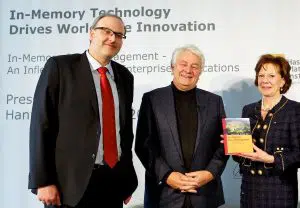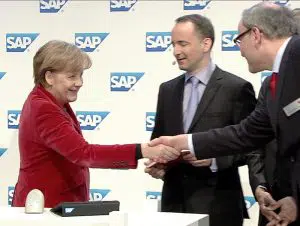Why we needed to invent a New Architecture based on In-Memory to develop new real-time applications?
The press release at the book launch highlights this perfectly:
If there are challenges to read the PDF, here is a small summary also:
In the last 50 years the world has been completely transformed through the use of IT. We have now reached a new inflection point. In our book published by Springer we present, for the first time, how in-memory data management is changing the way businesses are run. Today, enterprise data is split into separate databases for performance reasons. Analytical data resides in warehouses, synchronized periodically with transactional systems. This separation makes flexible, real-time reporting on current data impossible. Multi-core CPUs, large main memories, and cloud computing are serving as the foundation for the transition of enterprises away from this restrictive model. In this book, we describe techniques that allow analytical and transactional processing at the speed of thought and enable new ways of doing business. The book is intended for university students, IT professionals and IT managers, but it is also for senior management who wish to create new business processes by leveraging in-memory computing.
The second Book Edition “In-Memory Data Management ” is focusing on Application Development; the book is available since May 2012 by Springer. In the year since we published the first edition of this book, the performance gains enabled by the increased use of in-memory technology in enterprise applications has truly marked an inflection point in the market. The new content in this second edition focuses on the development of these in-memory enterprise applications, showing how they leverage the capabilities of in-memory technology.

Whats All is New in the Extended Edition of the In-Memory Book by Prof. Dr. h.c. Hasso Plattner, Prof. Dr. Alexander Zeier
About one year ago we published the first edition of this book. Within this last year, in-memory technology had such a big impact on the enterprise computing and application market that it truly marked an inflection point. This progress on the one hand, but also the resulting new questions on the other hand, convinced us that it is time for a new extended edition of our book. The new content in the second edition targets the development and deployment of data-intensive applications that are designed for leveraging the capabilities of in-memory database systems. Among other new content, we introduce an in-memory application programming model that includes the most important aspects and guidelines for developing in-memory applications. To ease the tasks of application developers and database administrators, we discuss the graphical creation of database views. Finally, we also elaborate on new features on the application level through the combination of data analytics and text search and by presenting two industry case studies Charite and Hilti.
First Edition of In-Memory/HANA Book launched at Cebit 2011
In 2011 we announced our book “In-Memory Data Management: An Inflection Point for Enterprise Applications” by Prof. Hasso Plattner and Dr. Alexander Zeier. This book is the culmination of five years worth of in-memory research. As such, it provides the technical foundation for combined transactional and analytical workloads inside the same database as well as examples of new applications that are now possible given the availability of the new technology. We have received numerous encouraging quotes by leaders from both academia and industry. The book is available at Amazon.
Many features described in the book as part of SanssouciDB, an idealized database system capturing all aspects of the authors’ long-term vision for enterprise data management, have been implemented in SAP HANA , which has been in ramp-up for selected customers since December 2010 and is generally available since June 2011.
We wrote this book because we think that the use of in-memory technology marks an inflection point for enterprise applications. The capacity per dollar and the availability of main memory has increased markedly in the last few years. This has led to a rethinking of how mass data should be stored. Instead of using mechanical disk drives, it is now possible to store the primary data copy of a database in silicon-based main memory resulting in an orders-of-magnitude improvement in performance and allowing completely new applications to be developed. This change in the way data is stored is having, and will continue to have a significant impact on enterprise applications and ultimately on the way businesses are run. Having real-time information available at the speed of thought provides decision makers in an organization with insights that have, until now, not existed.
This book serves the interests of specific reader groups. Generally, the book is intended for anyone who wishes to find out how this fundamental shift in the way data is managed is affecting, and will continue to affect enterprise applications. In particular, we hope that university students, IT professionals and IT managers, as well as senior management, who wish to create new business processes by leveraging in-memory computing, will find this book inspiring.
Book launch @ CeBIT 2011 with European Commissioner Neelie Kroes and book hand-over to Chancellor Angela Merkel
Launch at Cebit Event by Prof. Hasso Plattner, Prof Alexander Zeier, and European Commissioner Neelie Kroes.
Our book In-Memory Data Management: An Inflection Point for Enterprise Applications was launched on Tuesday, March 1st 2011 at “CeBIT, Hannover.
This page summarizes our book-related activities at CeBIT, ranging from a visit of Angela Merkel to our presence at SAP’s main booth in hall 4, where we answered detailed questions about the book throughout the week.
Discussion with Chancellor Angela Merkel
During her visit on the opening day of CeBIT, German Chancellor Dr. Angela Merkel visited SAP in hall 4, where Prof. Dr. Alexander Zeier presented the book to her and gave her a signed copy. Jim Hagemann Snabe, Co-CEO of SAP, showed the chancellor a prototype using in-memory technology, which was developed by our chair.
Prior to the launch, a panel discussion with Neelie Kroes (European Commissioner for the Digital Agenda) and the authors was held on the impact of in-memory technology on industry and society at the Haus der Nationen.
Following the panel discussion, Dr. Heinz Weinheimer (Executive Vice President, Springer) outlined the importance of the book for Springer in his welcome address. Afterwards, Prof. Dr. H.c. Hasso Plattner and Prof. Dr. Alexander Zeier answered questions about the content of the book.


